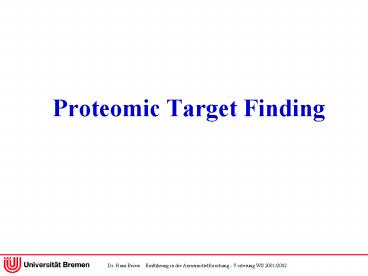Proteomic Target Finding - PowerPoint PPT Presentation
1 / 15
Title:
Proteomic Target Finding
Description:
Dr. Hans Briem Einf hrung in die Arzneimittelforschung - Vorlesung WS 2001/2002 ... Cut out individual spots. and determine their. amino acid sequence ... – PowerPoint PPT presentation
Number of Views:59
Avg rating:3.0/5.0
Title: Proteomic Target Finding
1
- Proteomic Target Finding
2
Genomics
protein
polysomal RNA
regulatory step 3
regulatory step 1 (polymorphisms)
genomic locus
Poly(A)RNA
transcript
regulatory step 2
3
regulatory step 5 post-translational modifications
Proteomics
protein
regulatory step 4
polysomal RNA
genomic locus
Poly(A)RNA
transcript
4
One genome - different proteoms
5
One genome - different proteoms
"Not only the genome, but in particular the
proteins present the proteome determine the
appearance and state of a biological
organism" (Taken from Lottspeich, F. Angew.
Chem. 1999, 111, 2630-2647)
6
What is the Proteome?
- "A proteome represents the protein pattern of an
organism ... at a certain moment and under
defined limiting conditions."
7
Why are the genome and the proteome often
uncorrelated?
- No biological state exists in which all possible
proteins of an organism are expressed (different
gene expression) - mRNA and protein amount is uncorrelated due to
- mRNA degradation
- translational control
- protein degradation
- posttranslational modifications (e.g.
glycosylation, phosphorylation etc.)
8
Why is genomics much more popular though than
proteomics?
- DNA/RNA can be treated much easier than proteins!
- proteins differ very much in their
physicochemical properties (solubility,
stability, charge etc.) - proteins are much more complex (large structural
variety) - no correlate to Gene Chips
- Gene technology has been developed to a very high
level (e.g. by the human genome project) - amplification (e.g. by PCR)
- sequencing
- disruption of gene function (e.g. by antisense
techniques)
9
Steps involved in Proteomics
- Sample preparation
- Protein separation
- Quantitative and sequence analysis of protein
spots - Database analysis of protein patterns by means of
bioinformatics - Protein chemical characterization and analysis of
posttranslational modifications
10
Protein separation is performed by 2D gel
electrophoresis
Cut out individual spotsand determine their
amino acid sequence
- First dimension IEF (isoelectric focusing)
- protein moves through polymer gel with pH
gradient strips - protein stops moving in the strip corresponding
to its isoelectric point - Second dimension SDS-PAGE (sodium dodecyl
sulfate-polyacrylamide gel electrophoresis) - protein is loaded with negatively charged SDS
- protein moves in electric field according to its
mass
11
Quantitative and Sequence Analysis of Protein
Spots
- Immunoblotting (Western Blot)
- Protein hydrolysis and amino acid composition
analysis - Microsequencing by Edman degradation
- MALDI-MS
12
Microsequencing of proteins by Edman degradation
13
Protein analysis is performed by MALDI-MS
(matrix-assisted laser desorption ionisation
mass spectroscopy)
14
Differential Proteome Analysis
15
Differential Proteome Analysis
- Differences can be measured between
- normal and diseased patients (target finding)
- patients before and after drug treatment
("pharmacoproteomics") - cells in different environmental or developmental
states































